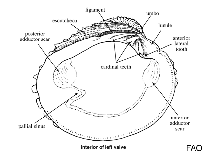Circomphalus disjectus (Perry, 1811)
Tasmania venus clam
Upload your photos
Google image | No image available for this species;
drawing shows typical species in Veneridae.
Google image | No image available for this species;
drawing shows typical species in Veneridae.
Classification / Names Common names | Synonyms | CoL | ITIS | WoRMS
Bivalvia | Venerida | Veneridae
Environment: milieu / climate zone / depth range / distribution range Ecology
Benthic. Temperate
Distribution Countries | FAO areas | Ecosystems | Occurrences | Introductions
Endemic to southern Australia and Tasmania.
Length at first maturity / Size / Weight / Age
Maturity: Lm ? range ? - ? cmCommon length : 5.1 cm SHL male/unsexed; (Ref. 360)
Short description Morphology
Shell: delicate, moderately swollen, equivalve and inequilateral, yellowish-whitish in color; sculpture has thin pink concentric lamellae, well-spaced, curve, grooved on the outer surface, prolonged posteriorly to form a spoutlike process; in between lamellae are thin growth lines; very longe ligament deeply set in the dorsal margin runs from the umbones to the end of the hinge which is heterodont with only three cardinal teeth on each valve; muscle scars almost equal (dimyarian, isomyarian); Pallial line has a shallow sinus (sinopalliate). Body: pair of gills each has two series of lamellae extensively fused in interlamellar junctions (eulamellabranch); foot and siphon moderately developed.
Life cycle and mating behavior Maturity | Reproduction | Spawning | Eggs | Fecundity | Larvae
Members of the class Bivalvia are mostly gonochoric, some are protandric hermaphrodites. Life cycle: Embryos develop into free-swimming trocophore larvae, succeeded by the bivalve veliger, resembling a miniature clam.
Main reference
References | Coordinator | Collaborators
Sabelli, B. and H.S. Feinberg (eds.). 1879. (Ref. 360)
IUCN Red List Status (Ref. 130435: Version 2024-1)
CITES status (Ref. 108899)
Not Evaluated
CMS (Ref. 116361)
Not Evaluated
Threat to humans
Harmless
Human uses
| FishSource |
Tools
More information
Trophic Ecology
Food items
Diet
Food consumption
Ration
Predators
Diet
Food consumption
Ration
Predators
Ecology
Ecology
Home ranges
Home ranges
Population dynamics
Growth
Age/Size
Length-weight
Length-length
Length-frequencies
Mass conversion
Recruitment
Abundance
Age/Size
Length-weight
Length-length
Length-frequencies
Mass conversion
Recruitment
Abundance
Life cycle
Distribution
Human Related
Aquaculture profile
Stamps, Coins Misc.
Stamps, Coins Misc.
Outreach
References
Internet sources
BHL | BOLD Systems | CISTI | DiscoverLife | FAO(Publication : search) | Fishipedia | GenBank (genome, nucleotide) | GloBI | Gomexsi | Google Books | Google Scholar | Google | PubMed | Tree of Life | Wikipedia (Go, Search) | Zoological Record



